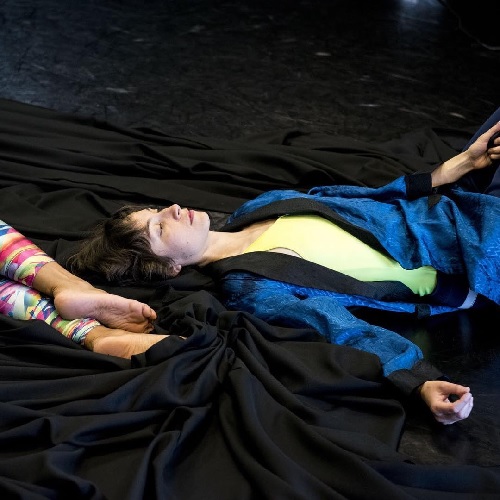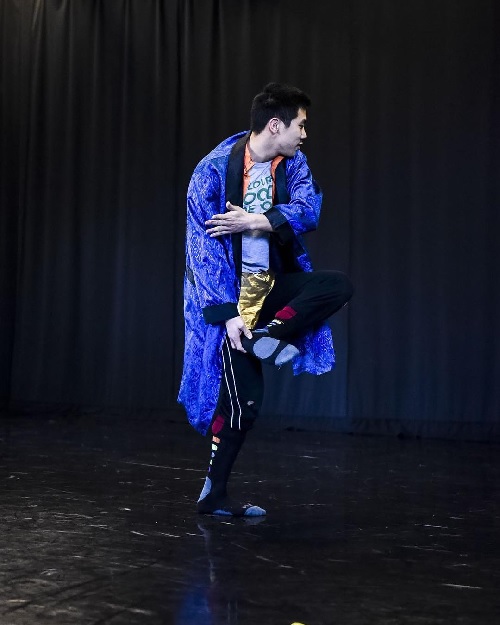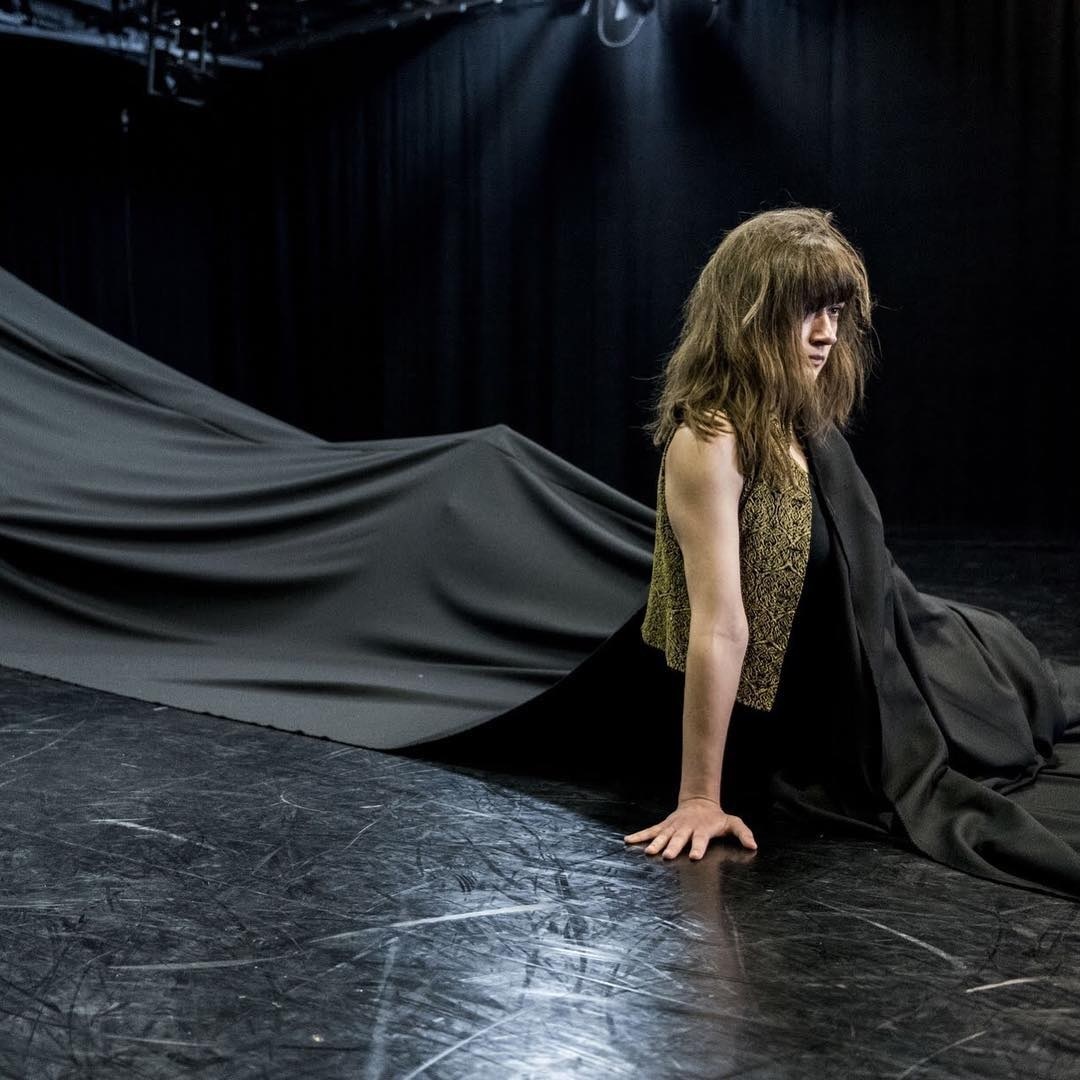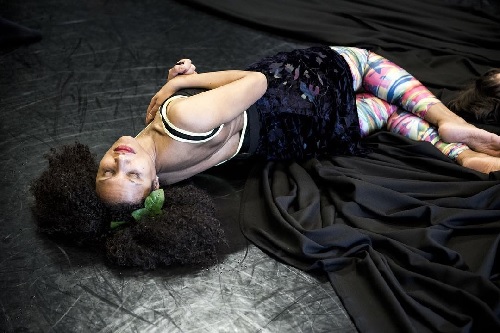Andrea Spaziani's Silver Venus - 2017/18
Created and performed with Irvin Chow, Alicia Grant, Julia Male, Francesca Chudnoff, and Nicole Rose Bond, with Music by Matt Smith. Created with Claire Turner-Reid
ASKED & ANSWERED
We’re turning to the artists with a series of interview questions for the team.
Dancemakers: Andrea, could you talk about how this work relates to the other works you've shown at Dancemakers - This Desiring Pony and Rafters?
Andrea: All three works were made using an autobiographical process of bringing consciousness to the unconscious and then giving that emergent material choreographic form. The only way I’ve managed to figure out doing that is by moving and talking at the same time for long durations. As I go, I capture thought and movement ideas with audio, video, typing and/or handwriting to calibrate where present, often personal, concerns lay. Eventually discreet ‘sections’ surface that form the choreographic score. In Rafters I was interested in ‘influence’, in This Desiring Pony I entered into live dialogue with my alter-ego, and in Silver Venus I’ve been working with the cast to re-create Venus as a living heterogeneous organism: a group persona that includes ideas we felt were missing from the representations of Venus that we’ve each encountered, and encountered differently. The fundamental questions behind these works are ‘why do I think the way that I do?’ and ‘what has been acting on me outside of my awareness?’
Silver Venus Collaborators' Photos by Omer Yukseker
Dancemakers: Matt - you have a really wide-ranging practice and skills set that involves everything from sewing to carpentry to composition, and within your music work there's again a huge variety of aesthetics and genres. I'm struck that Silver Venus seems to make particular use of this range of approaches and knowledge you have. Could you tell us a bit about how you are approaching this process and how your practices congeal (or don't) around a work like this
Matt: It is mostly insistence that separates things from one another. I hear little difference between genres, nor between the playing of a song and a DJ's playing of a song and the listening to of a song. And I see little difference in making a song, a sweater or a staircase. Andy's gaze is kind and generous. She has encouraged us to bring our whole selves to the work. Insistence is incompatible with Andy's more aquatic vision. I am so very grateful for the opportunity to add my work to a platter so profoundly adorned with the knowledge and the care and the talents of all of the collaborators.
Dancemakers: Fran - you've been documenting all our work at Dancemakers for the past two seasons, and this year have stepped in front of the camera twice - once was planned long-term, with you collaboration with Justin de Luna at Flowchart, and now as a (delightful) surprise pinch-hitter in Silver Venus. How does the experience of this work change for you from filming it to being inside of it?
Fran: The last two years of watching and capturing dance from the perspective of a camera continues to be a rejuvenating and surprisingly pleasurable experience for me. Jumping into the pool of Silver Venus has been a real trip. It’s like having a guest role on your favourite TV show, with all of your favourite people. At first, the work felt daunting, the score is so full and multilayered, but I’ve had mad fun this month. I feel very lucky that I’ve been able to experience this work on both sides.
Dancemakers: Nicole, you work as an interpreter all over and dance in such a variety of work. You frequently perform in work by some of the greats of Canadian Modern Dance, dancing in work that is between 30 and 50 years old. Could you please talk about how those rehearsal processes differ from Andrea's?
Nicole Rose Bond: Most of the remounting work I've learned has been similar in its process: The movement is often learned from video footage, with help from the choreographer, rehearsal director, and if one is lucky, a dancer who performed the piece. In remounting Silver Venus, rather than diving into particular movements and set choreography, our focus was on each section and its tasks, qualities and inspirations. We had the opportunity to go back and look at images, videos, and literature that inspired each section of the dance, and then enter long group improvisations for a long duration of time.
Dancemakers: Irvin, you came to dance relatively late in life for someone who works so often as an interpreter now. Can you tell us a bit about how you came to be a dancer, and how Andrea's process has been for you?
Irvin Chow: I started as a kind of rebellion to my life and wanted to shake up what I knew and how I interacted. The process is like that. These wonderful people keep shifting me and hopefully I dance good too.
Dancemakers: Alicia - you've danced in a lot of Andrea's work, have collaborated with her, and she has danced in your work. How long have you been collaborators and what drew you to working together? What keeps you working together?
Alicia Grant: Andrea and I have worked together since 2007. She welcomed me into some collective projects she was doing at the time. Self-produced chemicals, rigour and a huge bucket of humour keeps us working together, I think. Our roles are malleable. This, for me, supports our continued collaboration. I am so grateful for the time we have spent together sweating, laughing, dancing, brain-crunching....
Dancemakers: Julia, you're a frequent interpreter in improvised or score-based works, and have a choreographic practice also rooted in this kind of working. Could you tell me a bit about the difference between creating this work through your own body and interpreting the ideas of someone else?
Julia Male: One of the many things I love about working with Andy is that I do feel I like I’m creating the work through my own body, and I feel as committed to it and responsible for it as I do in my own work, with differences. At the same time, when I’m making work alone I often like to think that I am still just taking direction in a way.
About Andrea Spaziani
Andrea Spaziani has been making dances in Toronto for the past eleven years. She generates choreographic scores by moving and talking at the same time in a stream of improvisation. Her movements and words collapse into each other, asserting a new kind of attention that distorts the familiar, and challenges perception. Andrea has collaborated with artists across disciplines, and attended workshops and residencies internationally, most recently at HEIMA in Seyðisfjörður, Iceland. In 2016 she produced SPACEBODIES II for the Transart Triennale in Berlin, Germany as an experiment in choreography as curation, and in 2017 she co-founded the artist lecture series Archaeology of the Frivolous with Allen Ferguson in Marfa, Texas. Upcoming projects include Movement Research at the Judson Church, performance and video collaborations with Alicia Grant, and an exhibition with visual artist Morgan O’Hara in New York City in 2018. Published texts include Nostalgia for the Hadron Collider (2012), www.lonedancer.ca (2014), Exiting, Re-Existing (2015), and Unbecoming Ego (2016). She holds an MFA from The Transart Institute/ Plymouth University.







